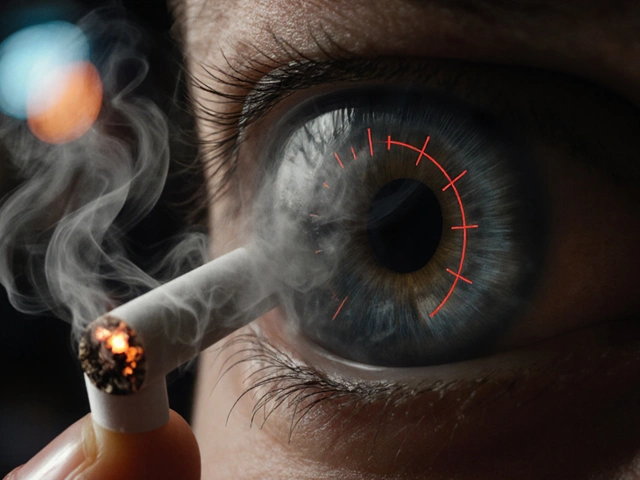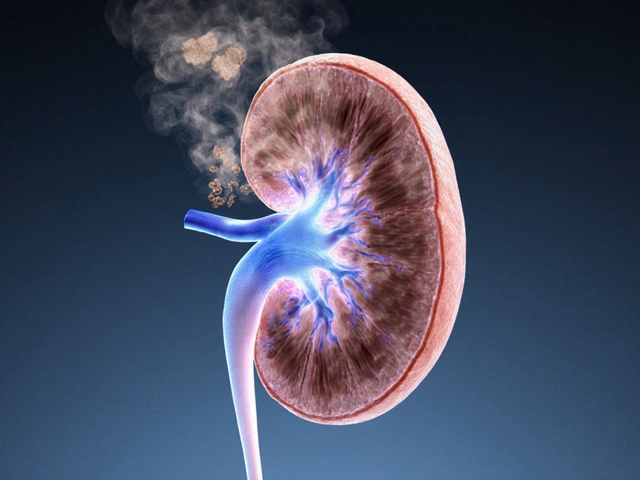Most people hear lurasidone and think of schizophrenia or bipolar depression. But if you’re struggling with anxiety-especially when it’s tied to mood disorders-you might be wondering: can lurasidone actually help?
What Is Lurasidone?
Lurasidone is an atypical antipsychotic, approved by the FDA in 2010. It’s sold under the brand name Latuda. Unlike older antipsychotics, it doesn’t slam into dopamine receptors everywhere. Instead, it’s picky: it targets serotonin 5-HT2A and dopamine D2 receptors just enough to calm overactivity without wiping out motivation or causing heavy sedation.
It’s mainly prescribed for schizophrenia and depressive episodes in bipolar I disorder. But here’s the thing-many people with bipolar depression also have severe anxiety. In fact, studies show up to 70% of people with bipolar depression report clinically significant anxiety symptoms. That’s why doctors sometimes reach for lurasidone even when anxiety is the main complaint.
How Lurasidone Might Help With Anxiety
Lurasidone doesn’t work like Xanax or SSRIs. It doesn’t boost serotonin directly. Instead, it rebalances brain signaling. Anxiety tied to mood disorders often comes from chaotic emotional regulation-not just a chemical imbalance. Lurasidone helps stabilize that.
A 2019 analysis of clinical trials involving over 2,000 patients with bipolar depression found that those taking lurasidone showed greater improvement in anxiety symptoms compared to placebo. The reduction wasn’t just in panic attacks or restlessness-it showed up in overall emotional volatility, irritability, and sleep disruption. These are all core parts of anxiety that meds like SSRIs often miss.
One real-world case from a clinic in Rochester involved a 34-year-old woman with bipolar II disorder. She’d tried five antidepressants. None touched her constant dread, racing thoughts, or physical tension. When her doctor added lurasidone 40 mg daily, her Hamilton Anxiety Scale score dropped from 28 to 12 in eight weeks. She didn’t feel ‘zombie-like.’ She just stopped feeling like she was on the edge of a panic attack all day.
It’s Not for Generalized Anxiety Disorder
But here’s the catch: lurasidone isn’t approved-and isn’t usually recommended-for pure generalized anxiety disorder (GAD), social anxiety, or OCD without a mood disorder component.
A 2022 review in the Journal of Clinical Psychiatry looked at 11 studies where lurasidone was tested in patients with primary anxiety disorders. The results were mixed. In patients without bipolar or major depressive disorder, lurasidone didn’t outperform placebo. It didn’t cause harm, but it didn’t help much either.
That’s because anxiety rooted in trauma, phobias, or chronic stress responds better to SSRIs, SNRIs, or therapy. Lurasidone’s strength is in calming the brain’s emotional thermostat when it’s broken by mood instability.

Who Might Benefit Most?
If you have:
- Bipolar depression with persistent anxiety
- Major depressive disorder with severe agitation or irritability
- Psychotic features during depressive episodes (like paranoia or racing thoughts)
- Failed multiple antidepressants
Then lurasidone could be a real option.
It’s often used as an add-on. So if you’re on an SSRI but still feel anxious, restless, or emotionally raw, your doctor might consider adding lurasidone instead of switching meds or upping the dose-which can make anxiety worse.
Side Effects to Watch For
Lurasidone is generally well-tolerated. But it’s not side-effect-free.
- Weight gain: minimal compared to other antipsychotics. Most people gain less than 2 pounds.
- Sedation: happens in the first few weeks, especially at higher doses. Taking it at night helps.
- Nausea: common in the first week. Take it with food (at least 350 calories). This is critical-lurasidone needs food to absorb properly.
- Restlessness or akathisia: a feeling of inner jitteriness. Can be managed by lowering the dose or adding beta-blockers.
- Increased prolactin: rare, but can affect libido or cause breast changes. More common in women.
Unlike olanzapine or quetiapine, lurasidone doesn’t spike blood sugar or cholesterol much. That’s a big plus for long-term use.
How It Compares to Other Options
| Treatment | Best For | Anxiety Reduction | Weight Gain Risk | Daytime Sedation |
|---|---|---|---|---|
| Lurasidone | Bipolar depression with anxiety | High | Low | Moderate |
| Quetiapine (Seroquel) | Insomnia + anxiety | Moderate | High | High |
| SSRIs (e.g., sertraline) | Generalized anxiety | Moderate | Low | Low |
| Benzodiazepines (e.g., lorazepam) | Acute panic | Fast but short-term | None | High |
Quetiapine works for anxiety too-but it’s a heavy sedative. Many patients can’t stay on it long because they feel too drowsy or gain weight. SSRIs are safer for long-term anxiety but often take 6-8 weeks to kick in and can worsen agitation early on. Lurasidone hits a middle ground: steady, not overly sedating, and doesn’t wreck your metabolism.

What If It Doesn’t Work?
Not everyone responds. About 30-40% of people with bipolar depression see meaningful improvement with lurasidone. If you’ve tried it for 8-12 weeks at the right dose (usually 40-80 mg/day, taken with food) and still feel anxious, it’s time to rethink.
Options include:
- Adding an SSRI or SNRI (like fluoxetine or venlafaxine)
- Trying mood stabilizers like lamotrigine, which also helps anxiety
- Switching to cariprazine, another newer antipsychotic with similar benefits
- Combining medication with CBT or DBT therapy
Don’t stop lurasidone cold turkey. Taper slowly under medical supervision. Withdrawal can cause rebound anxiety, nausea, or insomnia.
Realistic Expectations
Lurasidone won’t make your anxiety vanish overnight. It won’t fix trauma or life stress. But if your anxiety is tied to mood instability-your thoughts racing, your body on edge, your sleep shattered-it can bring you back to a baseline where therapy, routine, and self-care actually work.
One patient I spoke with said it best: ‘It didn’t make me happy. But it made me stop being terrified all the time. And that was enough to start rebuilding.’
Can lurasidone be used for anxiety alone, without depression or bipolar disorder?
No. Lurasidone is not approved or reliably effective for anxiety disorders like generalized anxiety disorder (GAD), social anxiety, or panic disorder without an underlying mood disorder. It works best when anxiety is part of bipolar depression or major depression with agitation.
How long does it take for lurasidone to help with anxiety?
Some people notice less restlessness or irritability within 1-2 weeks. But full improvement in anxiety symptoms usually takes 6-8 weeks. It’s not a fast-acting drug. Patience and consistency matter.
Does lurasidone cause weight gain?
Minimal compared to other antipsychotics. Most users gain less than 2 pounds over six months. It’s one of the few antipsychotics with a neutral effect on metabolism. Still, taking it with food (at least 350 calories) is required for absorption and can affect appetite.
Can I take lurasidone with an SSRI?
Yes, many doctors combine lurasidone with SSRIs like sertraline or escitalopram for treatment-resistant anxiety in mood disorders. This combination is common and generally safe, but it should be monitored for serotonin-related side effects like agitation or nausea.
Is lurasidone addictive?
No. Lurasidone is not addictive and does not cause physical dependence like benzodiazepines. However, stopping it suddenly can cause rebound anxiety or nausea. Always taper under medical supervision.
What’s the best time of day to take lurasidone?
Take it with a meal of at least 350 calories, preferably in the evening. It can cause drowsiness, so nighttime dosing helps with sleep and reduces daytime sedation. The food is essential-it improves absorption by up to 10 times.
Next Steps
If you’re considering lurasidone for anxiety, talk to a psychiatrist-not your primary care doctor. This isn’t a medication to trial casually. It requires careful monitoring of mood, movement, and metabolic health.
Keep a symptom journal. Note your sleep, energy, irritability, and anxiety levels weekly. That data helps your doctor decide if it’s working or if you need to adjust.
And remember: lurasidone isn’t a cure. It’s a tool. The real healing happens when you combine it with therapy, sleep hygiene, and routines that ground you. But for many, it’s the missing piece that finally lets them breathe again.







Lauren Hale
November 19, 2025 AT 01:23Lurasidone changed my life. I had bipolar II with anxiety so bad I couldn’t leave the house. Tried SSRIs, SNRIs, even benzodiazepines-none stuck. Lurasidone didn’t make me numb, just... steady. I still have bad days, but now I can breathe through them. Took about 6 weeks. Food is non-negotiable-skip it and you’re just wasting your time.
Greg Knight
November 20, 2025 AT 18:41I’ve been prescribing this for 5 years now. The key is patient selection. If someone’s got mood instability + anxiety, it’s gold. If they’re just stressed out from work or a breakup? No. It’s not an anxiety med-it’s a mood stabilizer with bonus anxiety reduction. I always tell patients: this isn’t Xanax, it’s a reset button for your nervous system. And yes, food. Always food. I’ve seen people quit because they took it on an empty stomach and blamed the drug. It’s not the med, it’s the missing sandwich.
rachna jafri
November 21, 2025 AT 03:46They don’t want you to know this but lurasidone is part of the pharmaceutical agenda to keep people docile. Big Pharma doesn’t want you healing through therapy or meditation-they want you dependent on pills that require food to work. Why food? Because they’re hiding something. The absorption rate? 10x? That’s not science, that’s a control mechanism. And why is it only approved for bipolar? Because they’re testing it on the mentally ill first. Next they’ll push it for ADHD, then for ‘high-performance workers.’ Wake up. They’re not treating you-they’re programming you.
darnell hunter
November 21, 2025 AT 16:33The assertion that lurasidone demonstrates efficacy in anxiety symptoms secondary to bipolar depression is supported by a limited number of clinical trials with methodological constraints. The 2019 analysis referenced exhibits significant heterogeneity in outcome measures and lacks subgroup analysis for anxiety-specific endpoints. Furthermore, the case study cited lacks controls, blinding, and longitudinal follow-up. One cannot extrapolate clinical utility from anecdotal evidence without randomized controlled data. Caution is advised.
Jessica Engelhardt
November 22, 2025 AT 07:55Martin Rodrigue
November 23, 2025 AT 18:46It is imperative to distinguish between adjunctive pharmacotherapy and first-line treatment. Lurasidone, while possessing favorable metabolic profiles, remains an off-label intervention for anxiety in the absence of a mood disorder. The pharmacodynamic profile-particularly its 5-HT2A antagonism-may exert downstream effects on limbic regulation, but this does not equate to anxiolytic efficacy in primary anxiety syndromes. The data remain inconclusive outside of bipolar depression.
Sherri Naslund
November 23, 2025 AT 18:54Ashley Miller
November 23, 2025 AT 20:07Oh wow, so the government finally found a way to make anxiety meds taste like regret and require a 350-calorie meal to activate? Genius. Next they’ll require you to recite the Declaration of Independence before your ADHD pill works. At this point, I’m convinced the real side effect is losing faith in humanity.
Margaret Wilson
November 24, 2025 AT 01:06OMG I’m so glad someone finally said this!! I was terrified to try it but my psychiatrist was like ‘just take it with a sandwich’ and I was like… okay fine. 8 weeks later I cried in the shower because I realized I hadn’t had a panic attack in 3 weeks. I’m not fixed. But I’m here. And that’s enough. 💛
william volcoff
November 24, 2025 AT 04:59For what it’s worth, I’ve seen patients on lurasidone + sertraline do really well. But you’ve gotta monitor for GI upset and akathisia. One guy I had thought he was ‘just jittery’-turned out he was in full akathisia. Dose down, added propranolol, and he was back to normal. Also-yes, food. I had a patient skip it, said ‘it didn’t work,’ then found out he’d been taking it on an empty stomach for 6 weeks. The drug wasn’t the problem. The sandwich was.
Freddy Lopez
November 25, 2025 AT 11:48There’s something poetic about a medication that doesn’t numb the pain, but restores the capacity to sit with it. Lurasidone doesn’t promise happiness-it offers space. Space to breathe. Space to heal. Space to realize you’ve been living in a storm and didn’t know the sky was still blue. Maybe that’s the real medicine: not fixing the mind, but giving it room to mend itself.
Brad Samuels
November 26, 2025 AT 13:07I’m a therapist and I’ve had clients on this med who finally started showing up to sessions. Not because they were ‘cured,’ but because they weren’t drowning anymore. One woman said, ‘I used to think my anxiety was me. Now I think it’s just a guest.’ That’s powerful. It doesn’t erase trauma, but it lets you hold it without breaking.
Mary Follero
November 26, 2025 AT 22:09Just wanna say-this post is SO helpful. I’ve been Googling for weeks and this is the first thing that made sense. My doc wanted to push me onto Seroquel but I was terrified. Lurasidone sounded scary but the side effects list actually made me feel hopeful. I started 40mg last week with a big dinner. Felt weird day 1, okay day 3, and yesterday? I went for a walk without checking my phone every 2 minutes. That’s a win. Thank you for writing this.
Will Phillips
November 28, 2025 AT 14:01Anyone taking this is a lab rat. Big Pharma knows this drug is barely better than placebo for anxiety. They’re pushing it because it’s patent-protected and costs $500/month. Meanwhile, real treatments-therapy, exercise, sleep hygiene-are free. But who profits from that? No one. So they sell you a pill that needs a sandwich to work. Pathetic.
Arun Mohan
November 29, 2025 AT 22:33Let’s be real-lurasidone is just the new ketamine for the middle class. You’re not treating anxiety, you’re chemically optimizing emotional compliance. I’ve seen rich folks on this while their therapists charge $300/hour. Meanwhile, the rest of us are stuck with CBT apps and self-help TikToks. It’s not medicine. It’s status signaling disguised as psychiatric care.